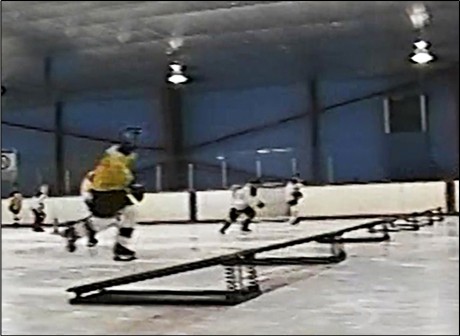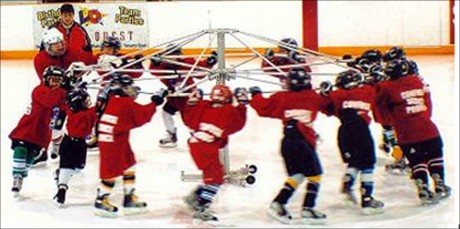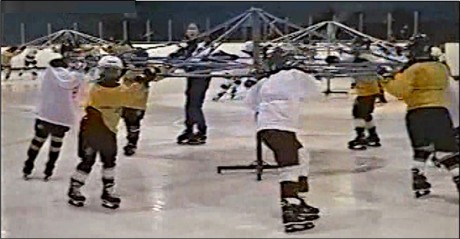2. Athletic Hall on Ice
First, you need to be an athlete, and then become a player!
The idea of creating an “Athletic Hall on Ice” came to me in America in 1973. The new facility Bay State Ice Arena, East Providence R.I., was where I established, the first of its kind in the world my private hockey school for children.
Previously, I worked with the master team of figure skaters of the Soviet Union and was familiar with the system of athletic and technical training for athletes of high calibre sportsmanship. In other words, “the player prior to participating in the competition must first be an athlete”. In my youth, in 1944, I was the gymnastics champion of Moscow at just 14 years of age.
The basic idea of “Athletic Hall on Ice” is the reasonable development of the basic athletic and volitional abilities in young players: flexibility, balance, coordination, speed, agility, courage, rhythm and tempo of movement and endurance.
In a word, “Athletic Hall on Ice”, a “programmed athletic development by using on ice mechanical apparatus” for technical and physical abilities of young players with an objective evaluation. In addition, “Athletic Hall on Ice” is the foundation of athletic training young hockey players, by my Hockey Agility Skills Development Pyramid.
(Viewing the development of hockey athletic skills)
Objective reality and subjective experience
Everyone knows that players, in addition train in gyms and stadiums under the guidance of their coaches. But objectively speaking, the process of preparing for a successful team to compete on the ice, players must train as long as possible “on skates, and not on their feet”.
Let me give some objective facts. On skate’s, the proportions of the upper and lower parts of the body are not the same, with and without them. The centre of gravity from the support on skate is considerably higher than without skates. Redistribution of power loads and speed on leg muscles, ligaments and tendons on legs are completely different with and without skates. Also, the stability of the equilibrium of the body and the vestibular system on ice with skates are not the same without them.
On the basis of this objective reality I have developed a revolutionary System of universal athletic development of young hockey players on the ice and called it “Gym on Ice”. “Gym on Ice” – consists of four units: the carousel, jumping boards, parallel bars and rubber cord.
A coaching team employing tactical drills, without the development of basic motor abilities and special individual technical skills in children’s hockey, is a “coaching camouflage”.
You can see level of physical condition the american and canadian youth and junior players during my first workouts on “Gym on Ice” and see the truth of my words on (www.hockeyagility.com) (educational video page).
“Retail training” or “mass training”
“Retail Training” on the ice on one or two or three players for 45-60 minutes is a “private” lesson, during which remains a lot of unused ice space.
“Gym on Ice”, is a training process simultaneously with 40-50 young hockey players for 60-90 minutes is “mass assembly-line learning”.
Great value of “Gym on Ice” is because this method gives objective visual evaluation of the physical and technical abilities of every hockey player. In addition, from a material point of view, “Gym on Ice” is a more efficient training method for children and their parents, as well as a very profitable format for the facility owners.
In other words, “Gym on Ice” is the “conveyor belt of sports training” systems where you can implement several apparatus on the ice and in still good life skills encase.
(View Athletic Hall in action)

|
Previous
|
Questions
|
Next
|


